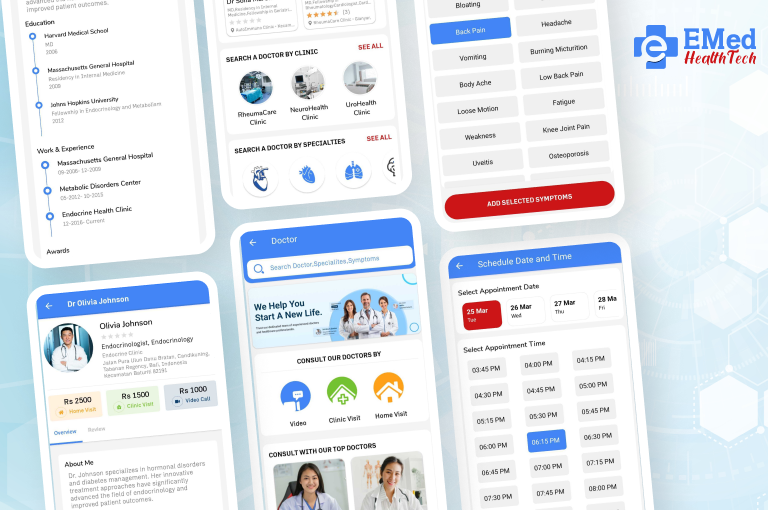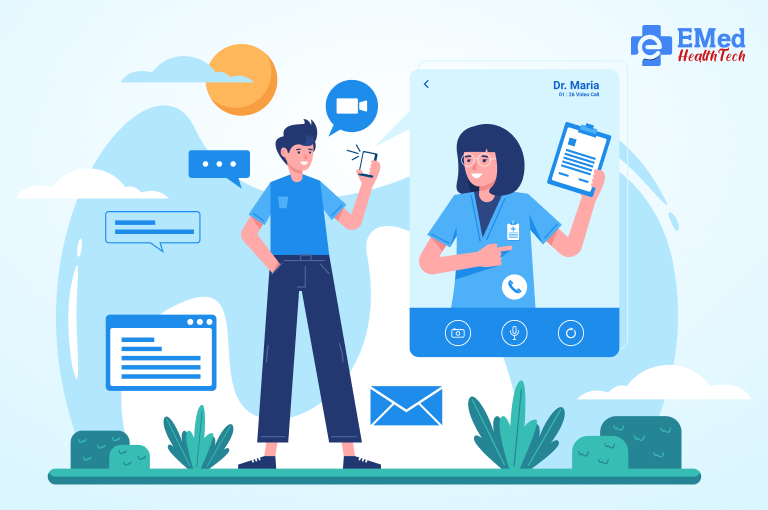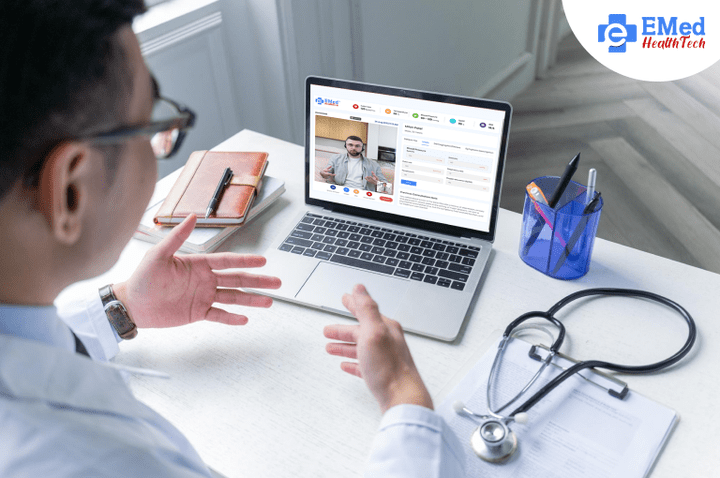Salim Chauhan
The phrase ‘Data is the new oil’ is a reality of present times. Every modern industry is heavily dependent on data, and therefore, guarding this critical resource has become extremely crucial.
While data security is necessary for every industry, it is more so for industries such as healthcare and telemedicine that handle sensitive information.
In this blog, we’ll discuss the importance of data security in telemedicine and how healthcare providers can follow the best industry practices when engaging in telemedicine app development.
What is Data Security in the Context of Telemedicine?
We know it’s necessary to have strict measures in place at the time of telehealth app development. Here’s why.
Data security in telemedicine is the digital extension of patient-doctor confidentiality. Any compromise in this information can have serious consequences. Critical patient information can be misused to carry out scams or identity theft. It could not only prompt those affected to take legal action but it also weakens the foundation of trust that a healthcare business would have taken years to build.
Why the Healthcare Industry Cannot Afford to Skimp on Data Security
For a long time, the healthcare industry has been prone to data security breaches and it has been a costly affair. According to an article published in the HIPAA Journal in 2023, IBM identified this industry as the darling of cybercriminals for the 13th year running (measured from April 2022 to March 2023) with the average cost of a breach gaining +8.22% YoY to $10.9Mn and a staggering +53.3% over the three year average.
The significant cost impact of a healthcare security breach can be further gauged from Statista which puts the financial sector at a distant second averaging only $5.9Mn per breach over the same period. All of this, despite Western governments mandating companies to comply with legal frameworks such as HIPAA in the USA and GDPR in the European Union to ensure watertight data handling mechanisms.
As telemedicine gained immense popularity during the recent COVID pandemic thanks to its remote consultation capabilities and with all the data being collected by the service providers for their records, the healthcare industry represented something of a treasure trove for hackers. Little wonder then that some of the biggest healthcare data breaches ever recorded were all in 2022. Prominent names such as Shields Health Care Group, Broward Health, Morley Companies, ARcare, and OneTouchPoint all feature on the list with data of a few million patients compromised.
Telemedicine App Development Strategies for Protecting Patient Data
When planning for telemedicine software, you need to ask the developer team to implement measures for effective patient data protection. In addition to that, here are certain best practices you can consider for your telehealth services app.
Using secure communication protocols:
Your app should feature secure communication protocols like SSL or TLS that will keep information encrypted and block any unauthorized interception.
Using strong, uncommon passwords:
Prompt users to set up strong, uncommon passwords that are difficult to guess. Users should also be forced to periodically update passwords. A two-factor authentication system adds to the protective layer and makes your system more robust against hacking attempts.
Data encryption across devices, at all times:
It is best to keep all data securely stored in the cloud. If you are using a storage device, ensure it is well-encrypted. Implementing data encryption ensures enhanced security, making it challenging for attackers to access information even if the device is lost. This remains a significant hurdle for hackers despite technological advancements. Encryption during data transmission via LTE and WiFi networks further safeguards against interception and misuse by unauthorized individuals.
Restricted patient data access:
Limit patient information access only to those who use it for their daily responsibilities. You will need to provide the doctor’s access to their patient’s data, but do you need to share the same information with the receptionist?
Implementing measures to prevent data loss:
Data Loss Prevention (DLP) tools help in identifying and protecting sensitive information against leaks by monitoring device and network activity such as instant messaging applications, file sharing, and email exchanges with external mail addresses.
Regular audits:
Security vulnerabilities often show up in system audits. Perform regular checks to address such concerns at a nascent stage before they snowball into a major security concern.
Software updates:
We often tend to postpone our software updates, worrying they will take up time in the middle of a busy day. Maintaining up-to-date software along with the latest security patches is vital as it protects you against cyber attackers. They are usually aware of the vulnerabilities that they can easily exploit to your disadvantage when you don’t have a security patch in place.
VPN usage:
VPN or Virtual Private Network is an encrypted internet connection that serves as a virtual gateway to a secure network. This is a useful and secure tool for healthcare personnel who need to have round-the-clock patient data access at their fingertips.
Providing secure teleconference space:
When you use audio and video codecs to provide a safe teleconferencing platform, confidential information exchange can take place without the risk of being exposed to unauthorized third-party interceptions.
Use of latest technology:
A secure telehealth app development is not enough if you don’t back it up with the latest security technologies including data encryption, anti-virus software, and firewalls.
Taking queue from industry best practices:
The healthcare industry has several best practices that you can bring to your telemedicine business including secure coding habits, password management policies, and Bring Your Device (BYOD) guidelines.
Providing employee training:
You can have the best-in-class security setup for your telemedicine software but what about your employees who will be at the forefront of managing the systems? Failure to train them properly on the importance of patient data protection will leave them vulnerable to social engineering attacks and could end up pouring cold water over all your efforts.
Planning for contingencies:
Sometimes, it is good to be a little pessimistic. What if, despite your best efforts, there is a security incident? With a proper contingency plan in place, you will know how best to respond and mitigate the damage as far as possible.
Scale Up Your Healthcare Business with Secure Telemedicine App Development
Are you looking for a telemedicine app development solution? At EMed HealthTech, we have been developing apps tailored to the unique needs of every stakeholder in the telemedicine business for 7+ years. Our secure, high-quality telemedicine app development platform assures increased patient satisfaction, in turn helping to boost revenues. With a team of highly qualified and experienced professionals, we have served over 500 clients across more than 34 countries.
Get in touch with our experts today to know more about how our development team can provide a foolproof, failsafe telemedicine app for your healthcare business.
Related posts

Telemedicine
How to Choose the Best Telemedicine App Development Company in the U.S.
Introduction The demand for telemedicine apps in the U.S. is at an all-time high, with healthcare providers rapidly adopting digital solutions to offer remote consultations and improve patient care. Choosing the right telemedicine app development company in the U.S. is crucial for ensuring seamless functionality, compliance with healthcare regulations, and a superior user experience. In […]
Read more
Telemedicine
Telemedicine in 2025: Top Mobile App Development Trends Shaping the Future of Healthcare
As we move into 2025, telemedicine is emerging as a key player in healthcare innovation. The rapid evolution of telemedicine app development redefines patient care and makes healthcare more accessible, flexible, and efficient.
Read more
Telemedicine
The Future of Telemedicine Platform: Trends to Watch in 2025
Telemedicine has rapidly become one of the most revolutionary aspects of modern healthcare. With its role in medical services expanding each year, the future of telemedicine is filled with incredible potential.
Read more







